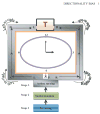Anticlockwise or clockwise? A dynamic Perception-Action-Laterality model for directionality bias in visuospatial functioning
- PMID: 27350096
- PMCID: PMC5003653
- DOI: 10.1016/j.neubiorev.2016.06.032
Anticlockwise or clockwise? A dynamic Perception-Action-Laterality model for directionality bias in visuospatial functioning
Abstract
Orientation bias and directionality bias are two fundamental functional characteristics of the visual system. Reviewing the relevant literature in visual psychophysics and visual neuroscience we propose here a three-stage model of directionality bias in visuospatial functioning. We call this model the 'Perception-Action-Laterality' (PAL) hypothesis. We analyzed the research findings for a wide range of visuospatial tasks, showing that there are two major directionality trends in perceptual preference: clockwise versus anticlockwise. It appears these preferences are combinatorial, such that a majority of people fall in the first category demonstrating a preference for stimuli/objects arranged from left-to-right rather than from right-to-left, while people in the second category show an opposite trend. These perceptual biases can guide sensorimotor integration and action, creating two corresponding turner groups in the population. In support of PAL, we propose another model explaining the origins of the biases - how the neurogenetic factors and the cultural factors interact in a biased competition framework to determine the direction and extent of biases. This dynamic model can explain not only the two major categories of biases in terms of direction and strength, but also the unbiased, unreliably biased or mildly biased cases in visuosptial functioning.
Keywords: Aesthetics; Anticlockwise; Bisection; Cerebral lateralization; Clockwise; Directionality bias; Dopamine; Dynamic model; Genes; Heritability; Mental number line; Neurogenetic; Orientation; Plasticity; Pseudoneglect; Rotation; Sensorimotor; Space mapping; Turning; Visuospatial perception.
Copyright © 2016 The Authors. Published by Elsevier Ltd.. All rights reserved.
Conflict of interest statement
Authors declare that they have no potential conflict of interest.
Figures







Similar articles
-
Dynamic stimuli: accentuating aesthetic preference biases.Laterality. 2014;19(5):549-59. doi: 10.1080/1357650X.2014.886585. Epub 2014 Feb 17. Laterality. 2014. PMID: 24527986
-
Visuospatial attention in line bisection: stimulus modulation of pseudoneglect.Neuropsychologia. 1999 Jun;37(7):843-55. doi: 10.1016/s0028-3932(98)00140-7. Neuropsychologia. 1999. PMID: 10408651 Clinical Trial.
-
Lateral biases and reading direction: a dissociation between aesthetic preference and line bisection.Brain Cogn. 2011 Apr;75(3):242-7. doi: 10.1016/j.bandc.2010.12.005. Epub 2011 Jan 6. Brain Cogn. 2011. PMID: 21215506
-
A review of behavioral evidence for hemispheric asymmetry of visuospatial attention in autism.Autism Res. 2023 Jun;16(6):1086-1100. doi: 10.1002/aur.2956. Epub 2023 May 26. Autism Res. 2023. PMID: 37243312 Review.
-
Lateral biases in aesthetic and spatial location judgments: differences between tasks and native reading directions.Laterality. 2020 Jan;25(1):5-21. doi: 10.1080/1357650X.2019.1577433. Epub 2019 Feb 7. Laterality. 2020. PMID: 30732541 Review.
Cited by
-
Visual communication via the design of food and beverage packaging.Cogn Res Princ Implic. 2022 May 12;7(1):42. doi: 10.1186/s41235-022-00391-9. Cogn Res Princ Implic. 2022. PMID: 35551542 Free PMC article. Review.
-
Directionality in Aesthetic Judgments and Performance Evaluation: Sport Judges and Laypeople Compared.Front Psychol. 2017 Dec 5;8:2109. doi: 10.3389/fpsyg.2017.02109. eCollection 2017. Front Psychol. 2017. PMID: 29259568 Free PMC article.
-
Mindfulness Meditation Biases Visual Temporal Order Discrimination but Not Under Conditions of Temporal Ventriloquism.Front Psychol. 2020 Aug 7;11:1937. doi: 10.3389/fpsyg.2020.01937. eCollection 2020. Front Psychol. 2020. PMID: 32903726 Free PMC article.
-
The right way to kiss: directionality bias in head-turning during kissing.Sci Rep. 2017 Jul 14;7(1):5398. doi: 10.1038/s41598-017-04942-9. Sci Rep. 2017. PMID: 28710346 Free PMC article.
-
Going through the motions: Biasing of dynamic attentional templates.J Exp Psychol Gen. 2024 Nov 7;154(1):111-27. doi: 10.1037/xge0001665. Online ahead of print. J Exp Psychol Gen. 2024. PMID: 39509202 Free PMC article.
References
-
- Adams GL. Effect of eye dominance on baseball batting. Research Quarterly. 1965;36:3–9.
-
- Afonso D, Santana C, Rodriguez M. Neonatal lateralization of behavior and brain dopaminergic asymmetry. Brain Research Bulletin. 1993;32(1):11–16. - PubMed
-
- Ahissar M, Hochstein S. The spread of attention and learning in feature search: effects of target distribution and task difficulty. Vision Research. 2000;40:1349–1364. - PubMed
-
- Ahissar M, Hochstein S. The reverse hierarchy theory of visual perceptual learning. Trends in Cognitive Sciences. 2004;8(10):457–464. - PubMed
Publication types
MeSH terms
Grants and funding
LinkOut - more resources
Full Text Sources
Other Literature Sources
Miscellaneous

